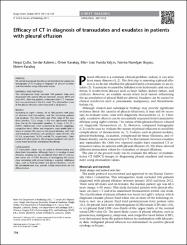Efficacy of CT in diagnosis of transudates and exudates in patients with pleural effusion

View/
Date
2014Author
Çullu, NeşatKalemci, Serdar
Karakaş, Ömer
Eser, İrfan
Yalçın, Funda
Boyacı, Fatima Nurefsan
Karakaş, Ekrem
Metadata
Show full item recordAbstract
PURPOSE We aimed to evaluate the efficacy of multidetector computed tomography (CT) imaging in diagnosis of pleural exudates and transudates using attenuation values. MATERIALS AND METHODS This retrospective study included 106 patients who were diagnosed with pleural effusion between January 2010 and June 2012. After the patients underwent chest CT, thoracentesis was performed in the first week. The attenuation values of the pleural effusions were measured in all patients. RESULTS According to Light's criteria, 30 of 106 patients with pleural effusions had transudates, and the remaining patients had exudates. The Hounsfield unit (HU) value of the exudates (median, 12.5; range, 4-33) was significantly higher than that of the transudates (median, 5; range, 2-15) (P = 0.001). Additionally, when evaluated by disease subgroups, congestive heart failure and empyema were predictable in terms of median HU values of the pleural effusions with high and moderate sensitivity and specificity values (84.6% and 81.2%, respectively; 76.9% and 66.7%, respectively). Compared with other patients, the empyema patients had significantly more loculation and pleural thickening. CONCLUSION CT attenuation values may be useful in differentiating exudates from transudates. Although there is an overlap in most effusions, exudate can be considered when the CT attenuation values are >15 HU. Because of overlapping HU values, close correlation with clinical findings is essential. Additional signs, such as fluid loculation and pleural thickness, should be considered and may provide further information for the differentiation.

















